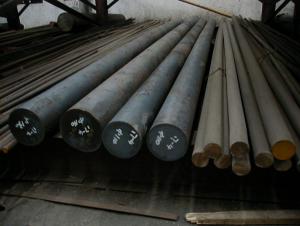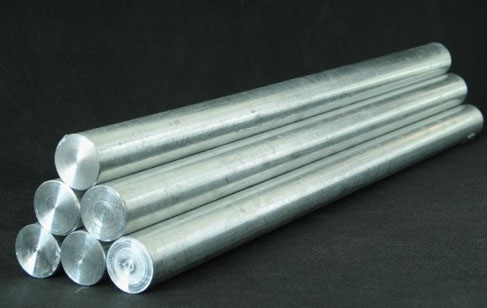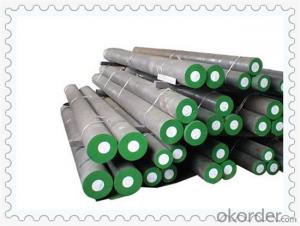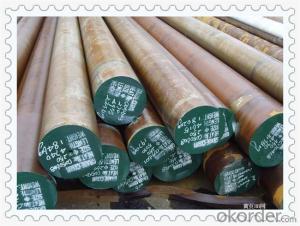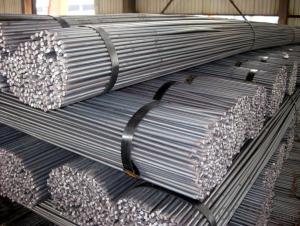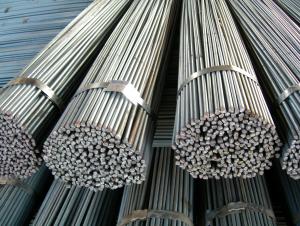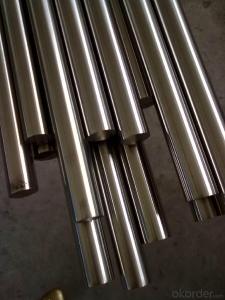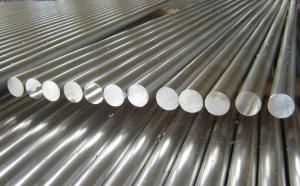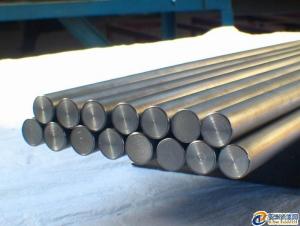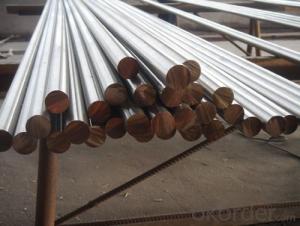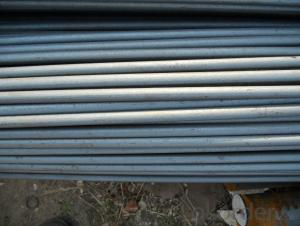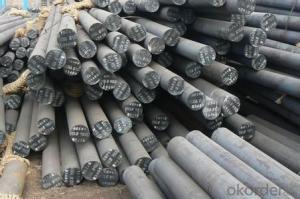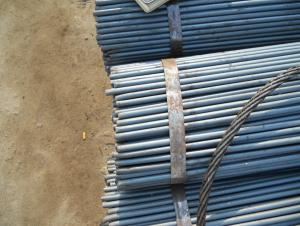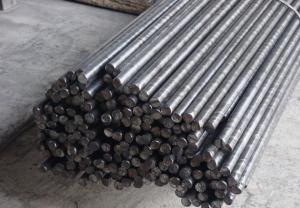Round Bar Hot Rolled High Quality Q195 Q235 8MM-22MM
- Loading Port:
- China Main Port
- Payment Terms:
- TT or LC
- Min Order Qty:
- -
- Supply Capability:
- -
OKorder Service Pledge
OKorder Financial Service
You Might Also Like
Product Description:
OKorder is offering Round Bar Hot Rolled High Quality Q195 Q235 8MM-22MM at great prices with worldwide shipping. Our supplier is a world-class manufacturer of steel, with our products utilized the world over. OKorder annually supplies products to European, North American and Asian markets. We provide quotations within 24 hours of receiving an inquiry and guarantee competitive prices.
Product Applications:
1) Suitable for making various strong cutting tool abrasion resistance, impact resistance.
2) Used to produce all kinds of high hard and super hard saw blade, drill, tap, broach, gear hob and various kinds of milling cutter.
3) Used for advanced punching die, screw die, and the toughness and complicated shape of the punch, etc.
4) Is used for cold forging die and drawing mode, etc.
5) Recommended watchcase factory, screw factory and other cold stamping products industry use.
Product Advantages:
OKorder's Round Bar Hot Rolled High Quality Q195 Q235 8MM-22MM are durable, strong, and resist corrosion.
Main Product Features:
· Premium quality
· Prompt delivery & seaworthy packing (30 days after receiving deposit)
· Corrosion resistance
· Can be recycled and reused
· Mill test certification
· Professional Service
· Competitive pricing
Product Specifications:
1. Grade: GB, JIS, ASTM, EN
2. Grade: Q235, SS400, A36, S235JR
3. Diameter and mass: As below
Diameter | Mass | Diameter | Mass | Diameter | Mass |
(mm) | (kg/m) | (mm) | (kg/m) | (mm) | (kg/m) |
6 | 0.22 | 22 | 2.98 | 53 | 17.30 |
7 | 0.30 | 24 | 3.55 | 56 | 19.30 |
8 | 0.40 | 25 | 3.85 | 60 | 22.20 |
9 | 0.50 | 26 | 4.17 | 63 | 24.50 |
10 | 0.62 | 28 | 4.83 | 65 | 26.00 |
11 | 0.75 | 30 | 5.55 | 70 | 30.20 |
12 | 0.89 | 32 | 6.31 | 75 | 34.70 |
13 | 1.04 | 34 | 7.13 | 80 | 39.50 |
14 | 1.21 | 36 | 7.99 | 85 | 44.50 |
15 | 1.39 | 38 | 8.90 | 90 | 49.90 |
16 | 1.58 | 40 | 9.86 | 95 | 55.60 |
17 | 1.78 | 42 | 10.90 | 100 | 61.70 |
18 | 2.00 | 45 | 12.50 | 120 | 88.85 |
19 | 2.23 | 48 | 14.20 | 140 | 120.93 |
20 | 2.47 | 50 | 15.40 | 150 | 138.82 |
4. Material: Mild Steel
5. Heat treatment of high quality steel:
Fire: Isothermal annealing temperature is 800 ~ 880 °C, with 10 ~ 20 °C, the furnace cooling to about 600 °C, hardness above HB269.
Preheat temperature: 730-730 °C
Quenching temperature: 1190-1210 °C
Tempering temperature: 540-595 °C
Cold drawn, hardness 285 HBS
Cold drawn after annealing condition, hardness 277 HBS
Quenching methods: oil quenching, air cooling or salt bath quenching
FAQ:
Q1: Why buy Materials & Equipment from OKorder.com?
A1: All products offered byOKorder.com are carefully selected from China's most reliable manufacturing enterprises. Through its ISO certifications, OKorder.com adheres to the highest standards and a commitment to supply chain safety and customer satisfaction.
Q2: How do you package the angle steel when shipping?
A2: All goods are packed in bundles with steel strips and shipped by container or break bulk.
Q3: The products are invoicing on theoritical weight or on actual weight?
A3: We can do it in both manners, according to the customers' request.
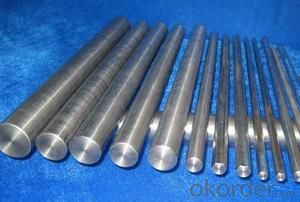
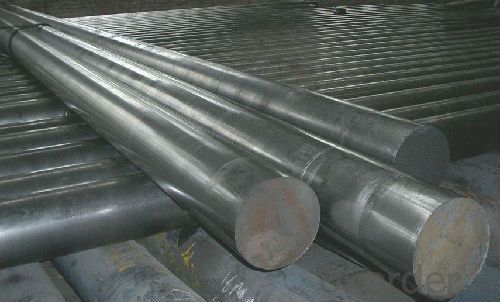
- Q: Can steel round bars be used for making renewable energy systems?
- Indeed, the utilization of steel round bars is feasible for the production of renewable energy systems. Steel, being a versatile material, finds extensive usage across multiple industries, including the renewable energy sector. Its robustness, longevity, and resistance against corrosion render it an ideal choice for fabricating frameworks, support structures, and components of renewable energy systems. For instance, steel round bars serve as an excellent building material for manufacturing wind turbine towers, solar panel frames, and support structures for hydroelectric power systems. Wind turbine towers necessitate a sturdy and stable structure to bear the weight of the turbine and endure the forces exerted by the wind. In this regard, steel round bars provide the requisite strength and stability, thereby ensuring the safety and efficiency of wind turbines. Similarly, solar panel frames require a sturdy construction capable of supporting the panels' weight and withstanding adverse weather conditions. Steel round bars can be employed to construct durable frames that securely hold the solar panels in place. Moreover, in the context of hydroelectric power systems, steel round bars prove invaluable in erecting support structures for various components like turbines, generators, and penstocks. Given the colossal pressure and force exerted by water flow, these structures need to possess the necessary durability and strength, making steel an exceptional choice for this purpose. All in all, steel round bars represent a dependable and frequently employed material in the construction of renewable energy systems. Their strength, durability, and resistance to corrosion render them suitable for diverse applications, thereby contributing to the long-term viability and sustainability of renewable energy sources.
- Q: What is the cost of steel round bars?
- The cost of steel round bars can vary depending on several factors such as the grade of steel, size of the bar, and the quantity being purchased. Generally, the price is determined by market conditions and can fluctuate over time. It is recommended to contact local steel suppliers or check online platforms that offer steel products to get the most accurate and up-to-date pricing information. Additionally, factors such as transportation and handling costs may also influence the final cost.
- Q: What are the advantages of using nitriding steel round bars?
- Nitriding steel round bars offer numerous benefits. Firstly, they possess a remarkable surface hardness. Through the nitriding process, nitrogen diffuses into the outer layer of the steel, creating a hard nitride layer. This greatly enhances the wear resistance and durability of the round bars, rendering them suitable for applications involving heavy loads or abrasive environments. Secondly, the fatigue strength of nitriding steel round bars is improved. The nitride layer formed during the nitriding process also enhances the steel's ability to withstand fatigue. Consequently, the round bars can endure repeated loading and high-stress conditions without experiencing premature failure. Moreover, nitriding steel round bars exhibit outstanding corrosion resistance. The nitride layer acts as a barrier against corrosive elements, such as moisture, chemicals, or saltwater, effectively protecting the underlying steel. This makes them ideal for use in harsh environments where corrosion is a concern, such as the marine or chemical industries. Furthermore, nitriding steel round bars retain a high surface hardness even at elevated temperatures. Unlike other surface hardening processes that rely on thin coatings, nitriding modifies the surface layer of the steel, resulting in a stable hardened layer that withstands high temperatures. This ensures that the round bars maintain their hardness and mechanical properties even in demanding heat-intensive applications. In conclusion, the advantages of utilizing nitriding steel round bars include high surface hardness, improved fatigue strength, excellent corrosion resistance, and high surface hardness retention at elevated temperatures. These properties make them the preferred choice for various applications in industries such as automotive, aerospace, manufacturing, and construction.
- Q: What is the elongation of a steel round bar?
- The elongation of a steel round bar refers to the amount it stretches or deforms when subjected to a tensile force. It is a measure of the bar's ability to withstand tension and is typically expressed as a percentage of the original length. The elongation is determined by the material properties of the steel, including its composition, grain structure, and heat treatment. Factors such as the applied force, temperature, and speed of loading also influence the elongation. Steel round bars generally exhibit a significant elongation before reaching their breaking point, making them suitable for structural applications that require high strength and ductility.
- Q: How do steel round bars compare to cast iron bars?
- Considered to be stronger and more durable than cast iron bars are steel round bars. Steel possesses a higher tensile strength and can endure greater loads and stress without distorting or fracturing. Moreover, steel exhibits superior resistance to corrosion and possesses a higher melting point in comparison to cast iron. An additional benefit of steel round bars lies in their versatility. Steel can be easily machined, welded, and shaped into various forms, making it suitable for a wide array of applications. Conversely, cast iron is brittle and challenging to manipulate. It possesses limited malleability and is prone to cracking or chipping under stress. Nevertheless, cast iron bars possess their own distinct properties that render them appropriate for specific applications. Renowned for its exceptional heat retention and distribution, cast iron proves ideal for applications such as cookware and engine blocks. It also boasts commendable vibration damping properties, which can prove advantageous in certain industrial applications. In conclusion, while steel round bars are generally regarded as superior in terms of strength, durability, and versatility, cast iron bars possess unique advantages in select applications. Ultimately, the choice between the two will depend on the specific requirements and conditions of the intended use.
- Q: Can steel round bars be annealed?
- Steel round bars can indeed undergo annealing, a heat treatment process in which the steel is heated to a specific temperature and gradually cooled. This procedure serves to alleviate internal stresses, enhance ductility, and improve the steel's machinability. Annealing can be employed on various steel products, including round bars, to render them more pliable, easier to work with, and minimize the likelihood of cracking or failure in subsequent manufacturing procedures.
- Q: How do steel round bars compare to wrought iron bars?
- Steel round bars and wrought iron bars have several differences that set them apart. Firstly, steel round bars are made from an alloy of iron and carbon, whereas wrought iron bars are composed of pure iron with a low carbon content. This difference in composition leads to varying properties. Steel round bars are known for their strength and durability, making them suitable for a wide range of applications, including construction, manufacturing, and engineering. On the other hand, wrought iron bars are softer and more malleable, allowing them to be easily shaped and formed into intricate designs. This characteristic makes wrought iron bars popular in decorative applications such as gates, fences, and ornamental pieces. Another difference lies in their manufacturing processes. Steel round bars are typically produced through hot rolling, which involves heating the steel billet and passing it through a series of rollers to shape it into the desired round bar form. In contrast, wrought iron bars are made through a labor-intensive process called blacksmithing. This involves heating the iron and repeatedly hammering it to remove impurities and create a fibrous structure, resulting in its characteristic grainy appearance. In terms of cost, steel round bars are generally more affordable compared to wrought iron bars. The manufacturing process for steel is more streamlined and efficient, leading to lower production costs. Wrought iron bars, on the other hand, require more time and labor, making them more expensive. Finally, when it comes to corrosion resistance, steel round bars have an advantage. Steel can be further alloyed with elements such as chromium, nickel, and molybdenum to enhance its resistance to rust and corrosion. This makes steel round bars suitable for outdoor applications where they may be exposed to moisture and harsh environmental conditions. Wrought iron bars, although they possess some level of corrosion resistance, are more prone to rusting and require regular maintenance to prevent deterioration. In conclusion, steel round bars and wrought iron bars differ in terms of composition, strength, manufacturing process, cost, and corrosion resistance. The choice between the two will depend on the specific requirements of the application, with steel round bars being favored for their strength and affordability, while wrought iron bars are often chosen for their malleability and decorative appeal.
- Q: Can steel round bars be plated?
- Yes, steel round bars can be plated. Plating is a common process used to enhance the appearance, corrosion resistance, and durability of steel round bars.
- Q: What are the limitations of using steel round bars?
- There are several limitations to using steel round bars. Firstly, steel round bars have a limited strength-to-weight ratio, which means they may not be suitable for applications that require high strength and low weight. Additionally, steel round bars can be prone to corrosion and rust if not properly protected or maintained. Another limitation is their inability to be easily shaped or bent, making them less flexible for certain design requirements. Lastly, steel round bars may not be cost-effective for small-scale or low-budget projects due to their higher material and manufacturing costs compared to other alternatives.
- Q: How do you prevent warping during welding of steel round bars?
- To prevent warping when welding steel round bars, there are several precautions that can be taken: 1. Ensure proper fit-up: Before welding, make sure the round bars are correctly aligned and fitted together. Any gaps or misalignments can cause uneven heating and cooling, increasing the likelihood of warping. 2. Divide welding into smaller sections: Instead of continuously welding along the entire length of the round bar, break it down into multiple smaller sections. This will help distribute heat more evenly and decrease the risk of warping. 3. Use low heat input techniques: Employ welding techniques like pulse welding or tack welding that minimize heat input. These methods allow for controlled and intermittent heating, reducing the chances of warping. 4. Consider preheating: Preheating the round bars before welding can also prevent warping, especially with thicker bars or when welding dissimilar metals. Preheating helps minimize the temperature difference between the weld and the surrounding material, reducing the risk of warping. 5. Monitor and control heat input: Keep a close eye on the heat input during welding. Excessive heat can cause rapid expansion and contraction, leading to warping. Use appropriate welding parameters, such as lower amperage and shorter welding times, to control the heat input. 6. Utilize welding fixtures: Use welding fixtures or jigs to securely hold the round bars in place during welding. This helps maintain proper alignment and prevents movement, reducing the chance of warping. 7. Allow for natural cooling: After welding, let the round bars cool down slowly and naturally. Avoid rapid cooling methods like quenching, as they can induce stress and increase the risk of warping. By implementing these measures, the likelihood of warping when welding steel round bars can be significantly reduced, resulting in higher quality and more dependable welded joints.
Send your message to us
Round Bar Hot Rolled High Quality Q195 Q235 8MM-22MM
- Loading Port:
- China Main Port
- Payment Terms:
- TT or LC
- Min Order Qty:
- -
- Supply Capability:
- -
OKorder Service Pledge
OKorder Financial Service
Similar products
Hot products
Hot Searches
Related keywords
